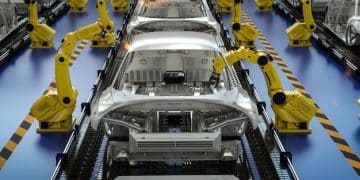Tariff Impact: US Auto Industry Under Pressure from 10% Parts Increase

Analyzing the Impact of the 10% Tariff Increase on Imported Auto Parts on US Car Manufacturers reveals potential disruptions in production, higher costs for consumers, and shifts in sourcing strategies for automakers, posing significant challenges to the US auto industry’s competitiveness.
The **Analyzing the Impact of the 10% Tariff Increase on Imported Auto Parts on US Car Manufacturers** is a complex issue with far-reaching implications. This new tariff is poised to reshape the economic landscape for both manufacturers and consumers alike. We will explore the projected changes.
Understanding the 10% Tariff on Imported Auto Parts
The introduction of a 10% tariff on imported auto parts has sent ripples throughout the US automotive industry. This levy, aimed at bolstering domestic production and reducing reliance on foreign suppliers, carries a complex web of potential consequences which will be unpacked.
What the Tariff Covers
The tariff specifically targets a wide range of auto parts sourced from overseas. These parts, essential for vehicle manufacturing, encompasses everything from essential components to smaller accessories.
- Engines and transmissions.
- Electronic components like sensors and control units.
- Body parts, including bumpers and hoods.
- Interior components such as seats and dashboards.
Reasons Behind the Tariff
Several factors contributed to the decision to impose this tariff. Proponents argue that it encourages domestic production, creating jobs within the US. Moreover, they suggest it reduces the country’s trade deficit and strengthens national security by decreasing dependence on foreign suppliers.
In essence, the 10% tariff on imported auto parts is an attempt to reshape the automotive supply chain, incentivize local manufacturing, and address broader economic goals related to trade and national security.

Immediate Effects on US Car Manufacturers
The immediate aftermath of the 10% tariff imposition has been palpable across the US automotive sector. Manufacturers are quickly assessing the implications for their bottom lines and operational strategies.
Increased Production Costs
One of the most direct and immediate consequences is the rise in production costs for US car manufacturers. With imported parts now being 10% more expensive, manufacturers face the challenge of absorbing these additional expenses or passing them on to consumers.
Many car manufacturers who previously relied soley on parts made outside the US are now struggling to stay within budget with the added tariff, which causes prices to rise for consumers.
Supply Chain Disruptions
The tariff has also led to disruptions in the automotive supply chain. Manufacturers who depend on imported parts may face delays in production as they scramble to find alternative suppliers or adjust their logistics to accommodate the new costs.
- Production delays for popular models.
- Increased lead times for parts procurement.
- Potential for vehicle shortages in the market.
Overall, the immediate effects of the 10% tariff on imported auto parts have introduced significant challenges for US car manufacturers. Increased production costs and supply chain disruptions force them to re-evaluate their strategies.
How Manufacturers Might Respond
Faced with the challenges posed by the 10% tariff, US car manufacturers are exploring various response strategies to mitigate the impact on their operations and profitability. These strategies include attempts to change production.
Finding New Suppliers
One potential solution is to diversify their supplier base. This involves sourcing parts from countries not subject to the tariff. While this approach can help offset the added cost, it may also require manufacturers to vet new suppliers.
Investing in Local Manufacturing
Another strategy is to invest in expanding domestic parts production capabilities. By increasing local manufacturing capacity, car makers can reduce their reliance on imported components, thus bypassing the tariff altogether. Government incentives and support may play a role in encouraging this shift.
Manufacturers could invest in new equipment and modern facilities to create cheaper parts made in the US and bypass tariffs completely.
Lobbying for Policy Changes
Automakers may also engage in lobbying efforts to advocate for policy changes or exemptions from said tariffs. They may work with industry associations to present data and arguments highlighting the negative consequences of the tariff on the automotive sector and the broader economy.

Impact on Consumers
While the 10% tariff directly affects car manufacturers, consumers are also likely to feel the effects throughout higher prices and reduced choices. The ripple effects of the tariff will eventually reach the wallets and preferences of car buyers across the country.
Potential Price Increases
As manufacturers grapple with higher production costs due to tariffs, they may pass some of these expenses on to consumers in the form of increased vehicle prices. Therefore, consumers may find themselves paying more for both domestic and imported car models.
Reduction in Car Sales
With increased new and used car prices people will be less likely to shop for a new car. This is due to the fact that household incomes have not caught up with inflation and the increased tariff.
- Shift in consumer preferences toward more affordable vehicles.
- Decline in demand for certain luxury or imported models.
- Postponement of car purchases among budget-conscious buyers.
Reduced Choices for Consumers
As manufacturers adjust their product offerings to adapt to the tariff, consumers may face limited choices in terms of available makes, models, and options. This is why less consumers are likely to find a car that perfectly fits what they need.
Sooner rather than later, the 10% tariff on imported auto parts will likely make it more expensive for consumers to purchase and maintain their vehicles. Increased prices, reduced choices, and potential shifts in the used car market are among the challenges that consumers may face.
Broader Economic Implications
Beyond the immediate effects on car manufacturers and consumers, the 10% tariff on imported auto parts has broader implications for the US economy as a whole. This is due to the interconnected structure it carries.
Impact on Employment
While proponents of the tariff argue that it will create jobs in the domestic auto parts industry, there are also concerns about potential job losses in other sectors, such as vehicle assembly and sales. If car sales decline due to higher prices, dealerships and related service providers may be forced to reduce their workforce.
More specifically, small dealerships and service providers would be hit since they rely on volume to make a profit, but larger firms will not be effect. Even larger firms will be affected, but the smaller ones will shut down.
Effects on Trade Relations
The decision to impose tariffs on imported auto parts can strain trade relations with other countries, especially those that are major suppliers of these parts. Retaliatory measures from affected nations can lead to trade disputes, tariffs on other goods, and disruptions in international commerce.
The US imposing tariffs will only cause other countries to impose tariffs when trading, thus starting a trade war between powerful economies.
Overall Economic Growth
The ultimate impact of the tariff on overall economic growth is a subject of debate among economists. While some argue that it can stimulate domestic production and investment, others warn that it can stifle economic activity by raising costs, reducing consumer spending, and disrupting supply chains.
Future Outlook for the US Auto Industry
Looking ahead, it is evident that the 10% tariff on imported auto parts will continue to shape the future landscape of the US auto industry in profound ways. As manufacturers adapt to the new realities of the market, several key trends are likely to emerge.
Increased Automation
To offset higher labor costs and enhance efficiency, car manufacturers may accelerate their adoption of automation technologies in the production process. This includes the use of robots, artificial intelligence, and computerized systems to streamline operations and reduce reliance on human labor.
- More car companies invest in robots.
- More employees are fired.
- Cars get cheaper to manufacture.
Technological Change
The rise of electric vehicles (EVs) and autonomous driving technologies are reshaping the auto business. This will in turn change the way the world looks at how cars are manufactured.
In conclusion, the future of the US auto industry will be shaped by a combination of policy decisions, technological innovation, and evolving consumer preferences. Car manufacturers that can adapt to these changes will be more equipped for the long term.
| Key Point | Brief Description |
|---|---|
| 💰 Increased Costs | Tariffs increase production and consumer costs. |
| ⚙️ Supply Chain | Tariffs can disrupt existing supply chains. |
| 📈 Automation | Manufacturers may increase automation to offset costs. |
Frequently Asked Questions
▼
The tariff effects a wide array of components. These include engines and transmissions to electronic parts and structural parts. It impacts various aspects of vehicle manufacturing.
▼
Manufacturers may respond by localizing production. They can also diversify supply chains. Lastly, they may pass costs to customers in increased prices or reduce costs by automation.
▼
The overall effect is complicated. It depends on many variables. But, the tariff has the potential. It also shifts trade policies, employment, and manufacturing investments in the U.S.
▼
A tariff is a tax or duty imposed on goods. This could be applied when those goods are transported across international borders. These are generally introduced by governments.
▼
As a consumer, you cannot directly avoid tariffs. They are applied to companies importing the parts. However, you can look for ways to lower prices; shop around.
Conclusion
In conclusion, the 10% tariff on imported auto parts presents a complex interplay of issues and challenges for the US automotive industry. From rising production costs and supply chain disruptions to potential price increases for consumers and broader economic implications, the tariff’s impact is far-reaching. As manufacturers navigate this evolving landscape, their responses will determine the future of the industry.





